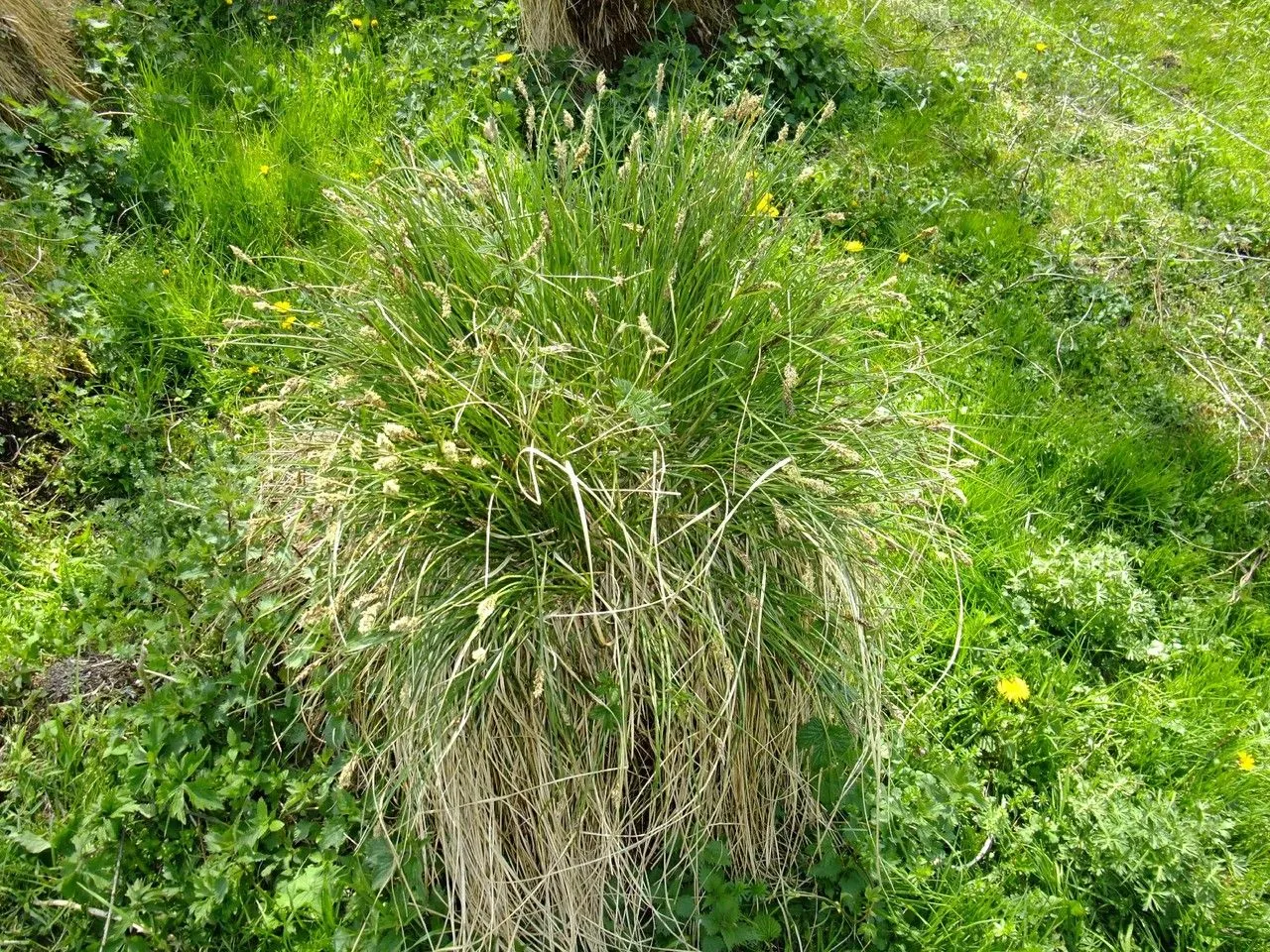
Author: L.
Bibliography: Cent. Pl. I: 32 (1755)
Year: 1755
Status: accepted
Rank: species
Genus: Carex
Vegetable: False
Observations: Canary Is., Europe to Caucasus
Greater tussock sedge, scientifically known as Carex paniculata, is a notable member of the Cyperaceae family. This resilient and adaptable plant thrives across a wide geographical range, from the Canary Islands to Europe and extending all the way to the Caucasus region. As documented in the Cent. Pl. I: 32 (1755) by L., Carex paniculata has a long history of observation and study.
The Greater tussock sedge is characterized by its robust, densely tufted growth form. It forms sizable clumps or tussocks that provide a unique structural component to the habitats it occupies. The plant exhibits long, narrow leaves that are typically dark green, contributing to its striking appearance in the landscape.
One of the key ecological roles of the Greater tussock sedge is in wetland environments, where it often establishes along the margins of streams, ponds, and marshes. Its extensive root system helps stabilize soil and prevent erosion, making it a vital species for maintaining healthy water ecosystems. Additionally, the dense tussocks offer shelter and habitat for a variety of wildlife, including insects, birds, and small mammals.
The flowering season of Carex paniculata typically occurs in late spring to early summer. The inflorescences are composed of numerous small spikelets borne on tall, slender stems, which rise above the foliage. These spikelets have a distinctive appearance, contributing to the overall aesthetic appeal and ecological value of this sedge.
In cultivation, Greater tussock sedge is occasionally used in landscape design, particularly in naturalistic and wildlife-friendly gardens. Its preference for moist, nutrient-rich soils makes it an ideal choice for rain gardens, bioswales, and along the edges of water features. However, its vigorous growth habit requires careful management to prevent it from becoming overly dominant in managed settings.
Overall, Carex paniculata stands out not only for its ecological importance but also for its historical presence and adaptability across diverse regions. It is a testament to the intricate interactions between plant species and their environments, offering both practical benefits and aesthetic interest.
Deu: rispen-segge
Dan: top-star
Nor: toppstarr
Eng: greater tussock sedge, greater tussock-sedge, panicled sedge, tussock sedge
Fra: laîche paniculée
Fin: lähdesara
Swe: lähdesara, vippstarr
Nld: pluimzegge
Nob: toppstarr
Nno: toppstorr
Ita: carice pannocchiata
Cym: hesgen rafunog fawr, hesgen rafunog fwyaf
En: Greater tussock sedge, Great Panicled Sedge, Great Tussock Sedge, Panicled Sedge, Greater Tussock-sedge, Tussock Sedge
Bg: Метличеста острица
Ca: Càrex paniculat
Cs: Ostřice latnatá
Da: Top-Star
Nl: Pluimzegge
Et: Pööristarn
Fi: Lähdesara
Fr: Laîche paniculée, Laiche paniculée
De: Rispen-Segge, Rispensegge
Hu: Bugás sás
Ga: Cíb thortógach mhór
It: Carice pannocchiata, Carice pannocchiuta
Lv: Skarainais grīslis
Lt: Šluotelinė viksva
No: Toppstarr
Nb: Toppstarr
Nn: Toppstorr
Fa: کارکس پانیکالاتا
Pl: Turzyca prosowa
Ru: Осока метельчатая
Sv: Vippstarr, Lähdesara
Uk: Осока волотиста
Cy: Hesgen rafunog fawr, Hesgen Rafunog Fwyaf
Taken Mar 19, 2022 by H L (cc-by-sa)
Taken Aug 20, 2022 by Andrzej Konstantynowicz (cc-by-sa)
Taken Jul 11, 2020 by Giode Tonpino (cc-by-sa)
Taken Jul 11, 2020 by Giode Tonpino (cc-by-sa)
Taken Aug 20, 2022 by Andrzej Konstantynowicz (cc-by-sa)
Taken Jun 30, 2016 by Tela Botanica − Florent BECK (cc-by-sa)
Taken May 5, 2017 by Antoine AFFOUARD (cc-by-sa)
Taken Jul 24, 2021 by Roberto Gardenghi (cc-by-sa)
Taken Nov 23, 2021 by Gwendolyn Slokker (cc-by-sa)
Taken Jul 11, 2020 by Giode Tonpino (cc-by-sa)
Taken Apr 27, 2012 by Tela Botanica − Yoan MARTIN (cc-by-sa)
Taken Mar 19, 2022 by H L (cc-by-sa)
Taken Aug 20, 2022 by Andrzej Konstantynowicz (cc-by-sa)
Taken Jul 11, 2020 by Giode Tonpino (cc-by-sa)
Taken Apr 27, 2012 by Tela Botanica − Yoan MARTIN (cc-by-sa)
Taken Jan 1, 1970 by Photoflora – L’Abbé COSTE (©)
Taken May 31, 1851 by Tela Botanica − Herbier PONTARLIER-MARICHAL (cc-by-sa)
Taken Apr 15, 2014 by Photoflora – Benoit BOCK (©)
Taken Apr 17, 2014 by Tela Botanica − Françoise CARLE (cc-by-sa)
Taken Aug 20, 2022 by Andrzej Konstantynowicz (cc-by-sa)
Taken Apr 9, 2016 by Tela Botanica − Yoan MARTIN (cc-by-sa)
Taken Apr 27, 2015 by Tela Botanica − Jean-Luc Gorremans (cc-by-sa)
Taken Aug 23, 2022 by Natural Ethik (cc-by-sa)
Taken Jun 30, 2016 by Tela Botanica − Florent BECK (cc-by-sa)
Taken Apr 27, 2015 by Tela Botanica − Jean-Luc Gorremans (cc-by-sa)
Taken May 5, 2017 by Antoine AFFOUARD (cc-by-sa)
Taken May 5, 2017 by Antoine AFFOUARD (cc-by-sa)
Taken May 5, 2017 by Antoine AFFOUARD (cc-by-sa)
Taken Mar 31, 2019 by Pierre-Yves PHILIPPOT (cc-by-sa)
Taken Dec 15, 2020 by Maryse M (cc-by-sa)
© copyright of the Board of Trustees of the Royal Botanic Gardens, Kew.
Growth habit: Graminoid
Ph maximum: 6.5
Ph minimum: 5.5
Light: 5
Atmospheric humidity: 9
Bloom months: [‘may’, ‘jun’, ‘jul’]
Soil nutriments: 5
Family: Myrtaceae Author: (F.Muell.) K.D.Hill & L.A.S.Johnson Bibliography: Telopea 6: 402 (1995) Year: 1995 Status:…
Family: Rubiaceae Author: Pierre ex A.Froehner Bibliography: Notizbl. Bot. Gart. Berlin-Dahlem 1: 237 (1897) Year:…
Family: Sapindaceae Author: Koidz. Bibliography: J. Coll. Sci. Imp. Univ. Tokyo 32(1): 38 (1911) Year:…
Family: Asteraceae Author: A.Gray Bibliography: Pacif. Railr. Rep.: 107 (1857) Year: 1857 Status: accepted Rank:…
Family: Fabaceae Author: Medik. Bibliography: Vorles. Churpfälz. Phys.-Ökon. Ges. 2: 398 (1787) Year: 1787 Status:…
Family: Aspleniaceae Author: (Cav.) Alston Bibliography: Bull. Misc. Inform. Kew 1932: 309 (1932) Year: 1932…